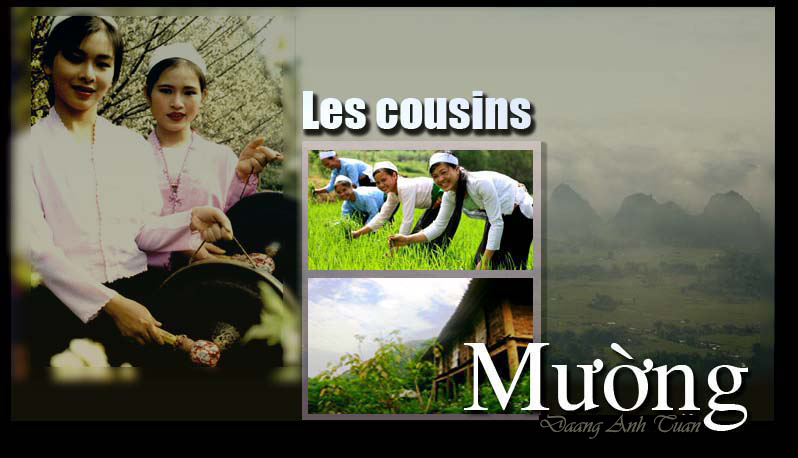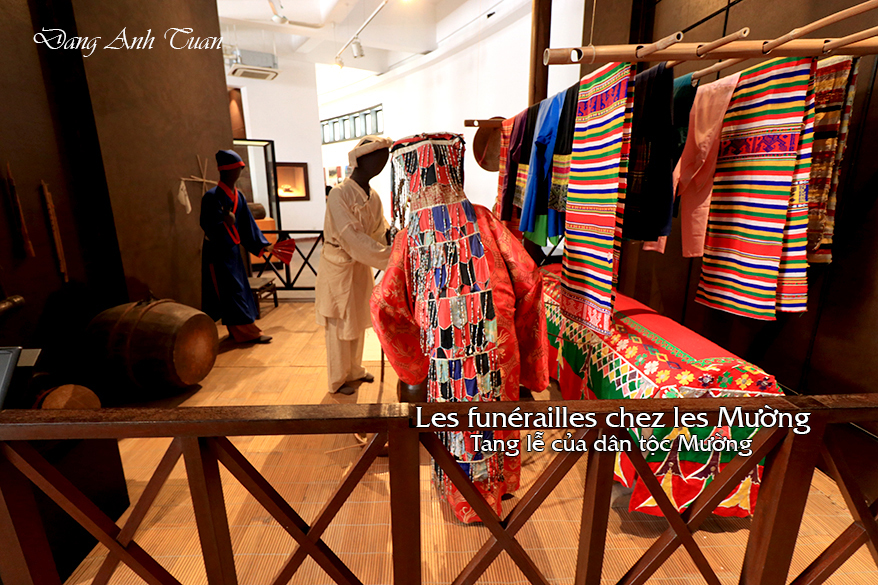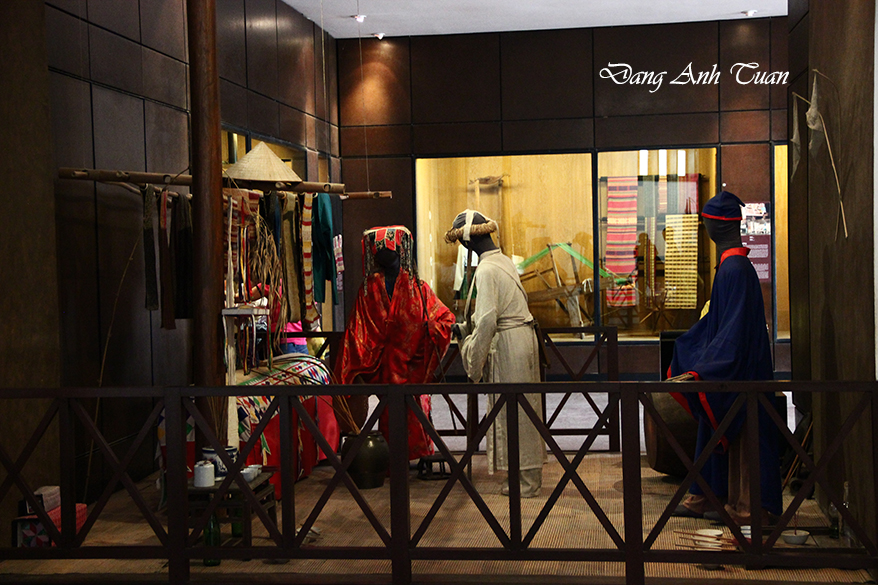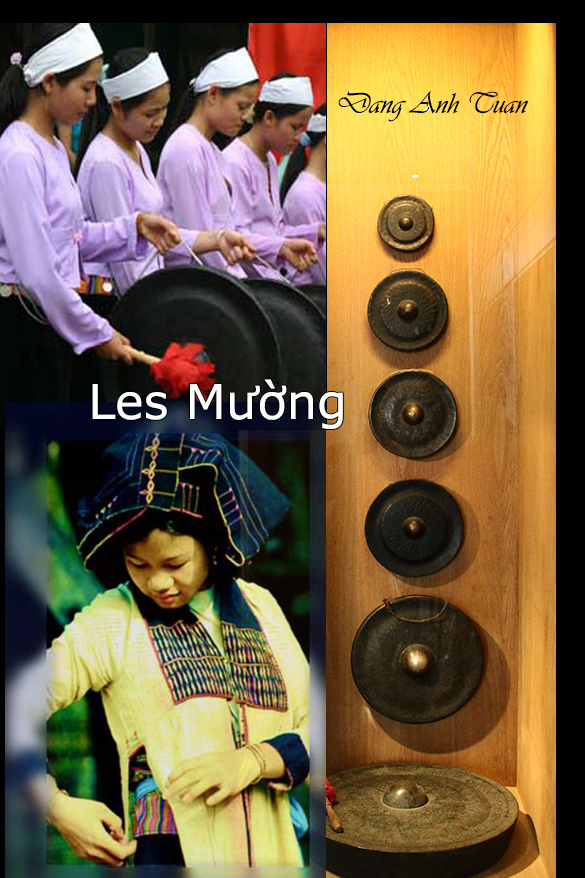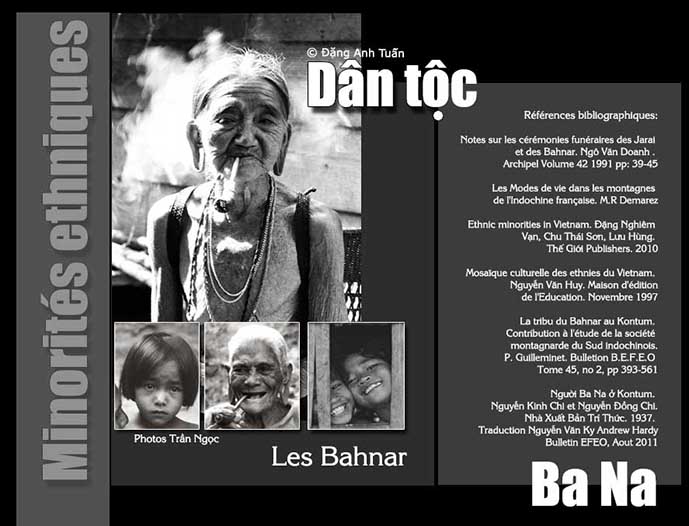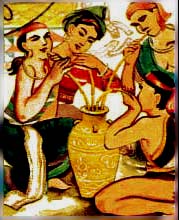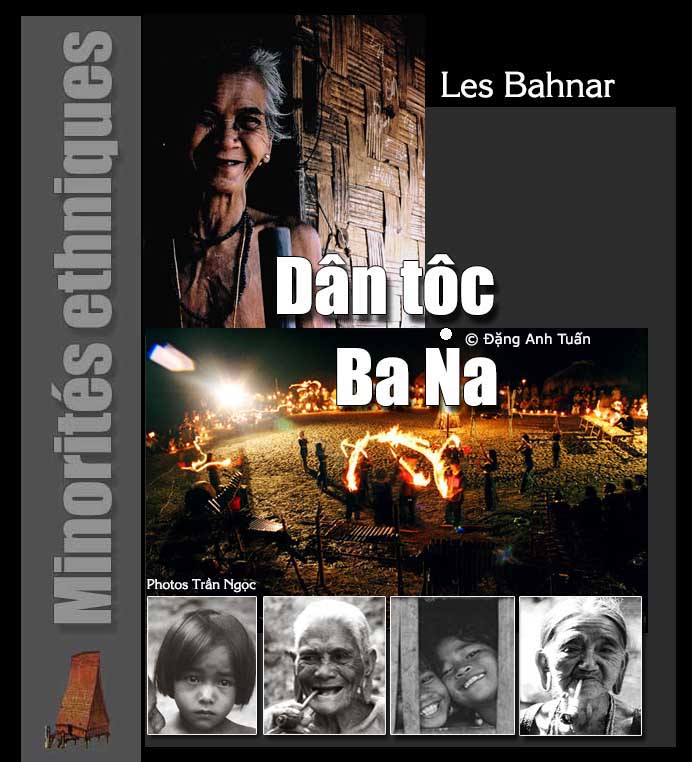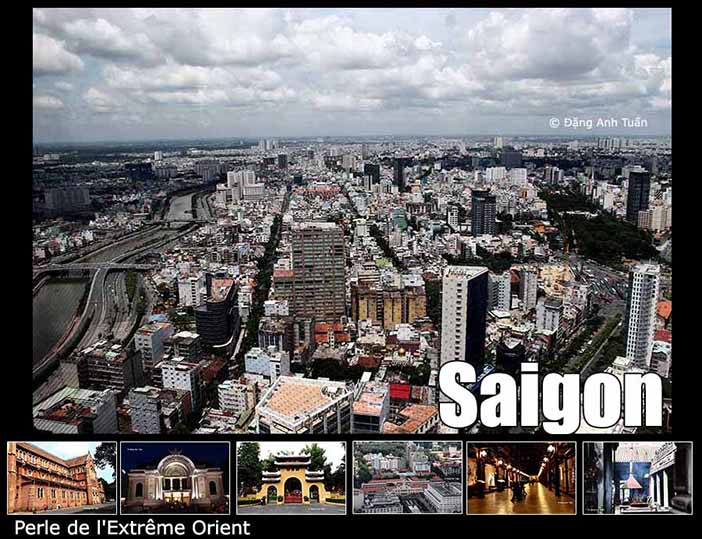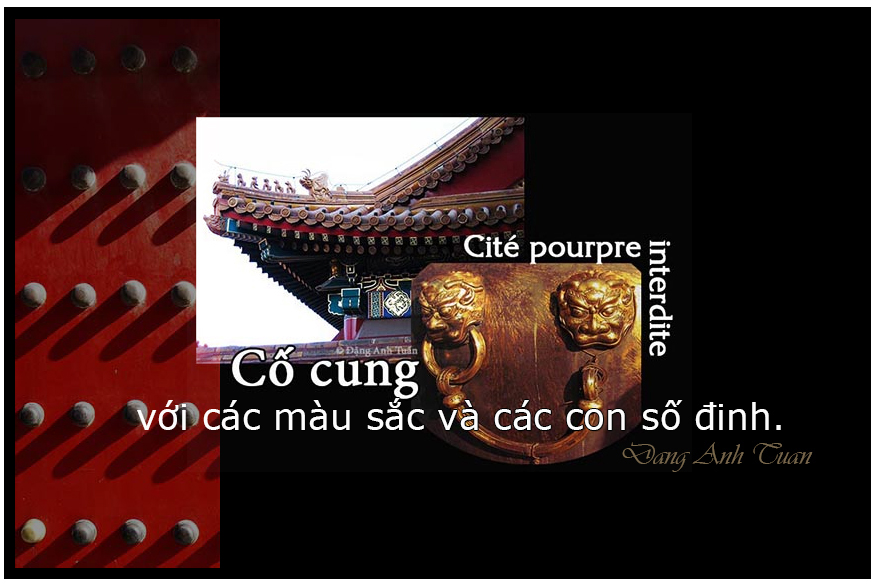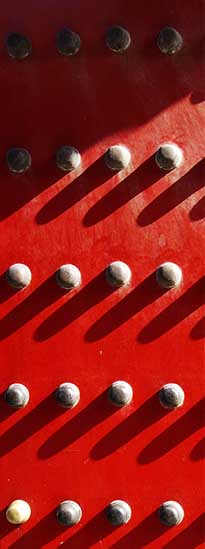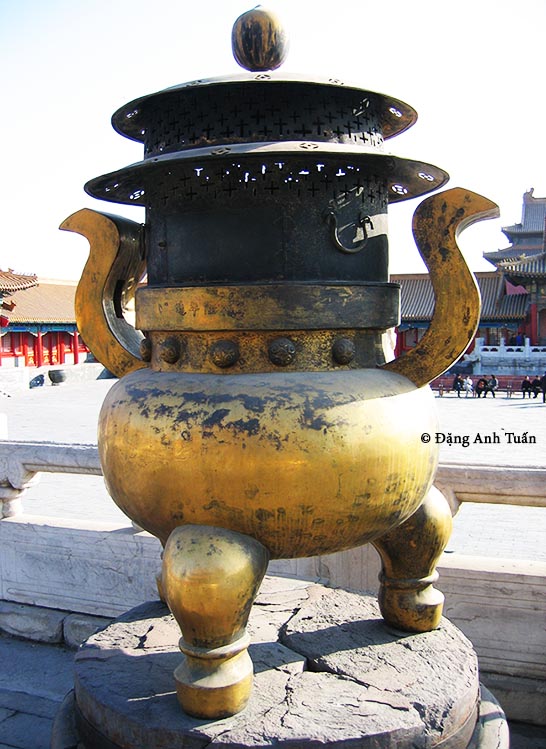The Nùng are part of the Tày-Thái group of the Austro-Asiatic ethnolinguistic family. According to foreign ethnologists, they are related to the Tày of Vietnam and the Zhuang or Choang (dân tộc Tráng) of China. Although the Tày and the Nùng speak their respective languages, they manage to understand each other perfectly. Their languages differ slightly in phonetics but are similar in vocabulary use and grammar. The Tày were present at the end of the first millennium BC.
This is not the case for the Nùng. Their settlement in Vietnam dates back to only about 300 years ago. However, their presence in southern China (Kouang Si (Quảng Tây), Kouang Tong (Quảng Ðông), Yunnan (Vân Nam), Guizhou (Qúi Châu), and Hunan (Hồ Nam)) is not very recent. They were also one of the ethnic groups of the Austro-Asiatic Bai Yue or Hundred Yue (Bách Việt) group. Also known under the name Tây Âu (Si Ngeou or Âu Việt) at a certain time, they played a major role in the founding of the second kingdom of Vietnam, the Âu Lạc kingdom of An Dương Vương, but they also engaged in relentless struggle against the Chinese expansion led by Emperor Qin Shi Huang Di (Tần Thủy Hoàng) with the Luo Yue (the Proto-Vietnamese). They also participated in the uprising of the two Vietnamese heroines Trưng Trắc and Trưng Nhị in the reconquest of independence under the Han dynasty.
They continue to preserve to this day many memories and legends about these two heroines in Kouang Si.
At a certain distant time, the Nùng were considered a branch of the Luo Yue living in the mountains before being definitively given the name « Choang » because they are closer to the Tày and the Thais than to the Vietnamese in terms of social organization and language. By calling themselves Cần Slửa Ðăm (people with black clothes) (người mặc áo đen), they claim to be different from the Tày, who are known as Cần Slửa Khao (people with white clothes) (người mặc áo trắng). Despite their clothes being the same indigo color, both peoples do not dress in the same way. This observation was noted by the Vietnamese writer Hữu Ngọc Hoàng Nam, author of the first monographic essay on the Nùng in Vietnam, who highlighted an important remark about the meaning of the words Đăm and Khao. For him, these allow the identification and distinction of subgroup membership within the Tày-Thai linguistic group through differences in clothing colors, dialects, and customs. Those belonging to Đăm (black or Đen in Vietnamese) include the Nùng, Black Thái, Thái, Black Hmongs, Black Lolo, etc., and those belonging to Khao (white or trắng in Vietnamese) include the Tày, White Thái, Lao (or Dao), White Lolo, White Hmongs, etc.
This remark does not convince the Vietnamese linguist Hoàng Mai, who comes from the Tày people, because for the latter, the Tày, despite belonging to the « Khao or White » group, always wear black clothes. Moreover, the word Slửa is not simply a word designating everyday clothing but is somewhat Áo hồn (Slửa Khoăn) because among the Thais, the Tày, and the Nùng, a garment symbolically represents the living soul of each individual. This was reported by the Vietnamese ethnologist Cầm Trọng in his article entitled « The Participation of Thai Culture in the Formation and Evolution of Vietnamese Culture » (International Conference on Thai Studies (1984/08/22-24; Bangkok).
Relying on this strong argument, he was led to conclude that the word pair Đăm – Khao (Black-White) should rather belong to the domain of spiritual culture because it is used to trace back the origin of subgroups within the Tày-Thái ethnic group, just as among the Vietnamese it is customary to evoke the word pair Rồng-Nước represented respectively by Lạc Long Quân and Âu Cơ to trace their origin.
The Nùng are divided into several subgroups known under different names: Nùng Inh, Nùng, Dính, Nùng An, Nùng Phàn Sinh, Nùng Cháo, etc. These names originate from the migration of the Nùng coming from the provinces of Kouang Si and Kouang Tong in China. In Vietnam, the Nùng are located in mountainous regions, deep forests, or valleys with altitudes not exceeding 300 meters above sea level. They often live mixed with the Tày in the provinces of the Upper Region. But their concentration is higher in Lạng Sơn (43% of the province’s population) and in Cao Bằng (32%). Most Nùng live in stilt houses, but there is still a small minority who prefer to live in houses at ground level with rammed earth or unfired brick walls.
Before building the house, the owner must carefully examine the horoscope of their age to find a favorable year for construction. Sometimes it is necessary to wait at least 2 or 3 years to find it. Their presence is essential at the time of clearing the construction site, establishing the foundation and columns, and setting up the roof.
The orientation of the house is one of the important criteria that the owner cannot neglect because it could be responsible for all misfortunes for him and his family. It is customary to say in the Nùng language: đảy kim dòm mò mả, thong thả dòm tì lườn. (Success in business comes from ancestral tombs. We are safe thanks to the land and the orientation of the house).
Demographically, they are ranked 7th among the 54 ethnic groups in Vietnam. In their history, the Nùng also have the legend of Báo luông Slao Cải. It is the story of the benevolent giant who cleared the land and taught them how to grow rice, corn, cotton, and everything they needed. The Nùng are accustomed to wearing fairly simple clothing, without embroidery or patterns. These are made from coarse indigo-colored fabrics. This color harmonizes with nature in the green environment of the forest. Their clothing can vary from light to dark shades of indigo. This variation depends on the preference of each Nùng group. Indigo remains the symbol of loyalty, as told by a Nùng legend:
There was a poor orphan living in a hut at the edge of the forest. One fine morning, a young beggar appeared at her door and asked for food. Being so poor, she could not offer him any. She had to go to the market to sell her beautiful hair and bought food for him. From that day, they became husband and wife. Because of the war, he was forcibly enlisted and never returned. Tired of not receiving any news, she set out to look for him and died along the way. She transformed into an indigo plant whose leaves provide indigo, a color that is everlasting and synonymous with loyalty through the ages.
In the traditional costume of Nùng women, there is the turban scarf, the jacket, and the pants. Generally speaking, regardless of the Nùng group, there is always a square turban, a five-panel jacket buttoned under the right armpit and extending down below the hip, and loose pants called chân què (*) whose upper edges are folded over with a turned belt. Depending on the Nùng group, there are slight modifications to the jacket. This is the case for the Nùng In and Phàn Slình groups, whose women wear jackets with sleeves and button bands decorated with black pieces. However, for the Phàn Slình Cúm Cọt group, the jackets are shorter than those of the other groups and are accompanied by red fringes around the neck. Only the details differentiate these groups. On the other hand, Tày women wear long dresses reaching the calf with fairly tight sleeves. Regarding the pants, most Nùng women wear classic loose chân què pants, except those from the Nùng Dính group who are accustomed to wearing skirts with belts adorned with 12 colored pieces symbolizing the twelve months of the year.
Their jewelry is made of silver because, in their ancestral traditions, it protects them against harmful winds that affect their health. Besides the aesthetic beauty that this metal can provide, it is always considered a thermometer in assessing seasonal epidemics. Nùng women and men are accustomed to wearing necklaces, bracelets, and rings. Additionally, Nùng women’s adornments include earrings and chains around their waists.
As for Nùng men, their trousers are of the same style as those of their women. Their jacket, with a stand-up collar about 2 cm high, is open at the front and adorned with 7 fabric buttons and 4 pockets. The Nùng have several Tết celebrations throughout the year, but the lunar Tết remains their major festival. This is celebrated with great pomp and marked by the presence of a large number of delicious dishes in each family to bid farewell to the old year.
The Nùng customarily eat a duck because it helps to get rid of the bad luck they had during the old year and brings them good fortune with the new year. On the eve of the new lunar Tết, the Nùng woman must fetch water from the well with a bucket. Then she boils it to make good tea before offering it to the ancestors. As for the Nùng husband, he must visit the temple to make offerings. There are many prohibitions that must be respected during the first days of the lunar new year:
Cúng hỉ phát sò (Wishing happiness and prosperity)
I send you my best wishes for happiness and prosperity
Bươn chiêng pi mấu (The first month of the new year)
for the month of February of the new year
Hét lăng tú lì (Anything is allowed)
You will be permitted to accomplish your achievements
Chi lăng tú đẩy a (May all wishes come true)
and to realize all your wishes
Nùng women are not allowed to wash clothes on New Year’s Eve. Chickens cannot be killed. Oxen and buffaloes must not be mistreated. Bowls must not be broken and cleaning should not be done.
On the second day, chickens may be slaughtered to offer to the ancestors and spirits. Visits to relatives, especially to the maternal family (Bên ngoại), are permitted. Children will receive money that adults customarily give them in small envelopes known as « bao lì xì.«
From the third day, in each village, the Nùng organize a popular festival called « Hội Lùng Tùng » (descent to the fields), often held on the land in front of their communal house. The participation of each family is visible with an offering tray. The presence of a shaman is essential because he is supposed to perform the rites to gain the favor of Heaven for agricultural activities and better harvests and to protect people from diseases. Besides the ritual ceremony, there are also folk games: lion dances, cloth ball throwing (chơi ném còn), tug of war (kéo co), spinning top launching, shuttlecock kicking, etc. It is also an occasion for girls and boys to get to know each other by forming groups for alternating songs, and slì exchanges between two young girls and two young boys.
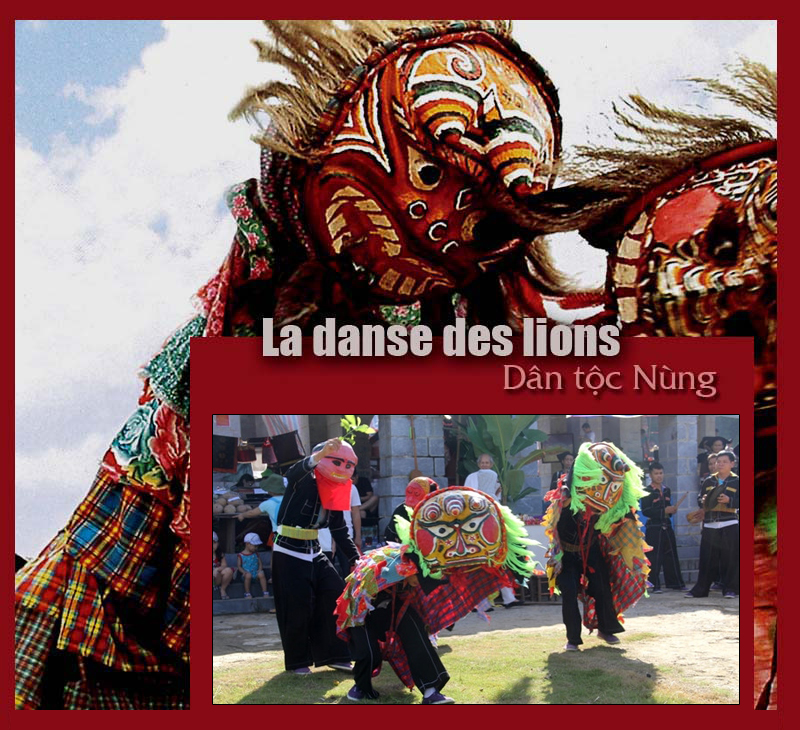 Lion dance
Lion dance
Similar to other ethnic minorities in Southeast Asia, the Nùng are animists. They believe that there is a soul that animates not only living beings but also plants, stones, etc. That is why their worship includes a large number of spirits: forest spirit, earth spirit, mountain spirit, river and stream spirits, tutelary spirit, childhood spirit (Mụ Mẹ Hoa), etc.
Similar to other ethnic minorities in Southeast Asia, the Nùng are animists. They believe that there is a soul that animates not only living beings but also plants, stones etc. That is why in their worship we see a large number of spirits: spirit of the forest, spirit of the soil, spirit of the mountains, spirit of the rivers and streams, tutelary spirit, spirit of childhood (Mụ Mẹ Hoa), etc.
But the most important worship remains the ancestor worship. Each Nùng household has an altar always placed in a left compartment. This is a sacred place. At the center of this altar is a wall ancestral tablet (or a bài vị) bearing parallel sentences and Chinese characters recording the lineage of the ancestors. Generally speaking, the head of the family plays an important role in all respects.
Being both father and husband, he is the only one who can arbitrate all family problems, especially the division of property. This will be done upon the death of the parents or when one of the married children, who had been living under the same roof, separates. Only boys can claim this division. The eldest brother will then receive a significant share because he will be responsible for living with the parents. However, there is an exception for the Nùng Dín Hoàng Sa Phì group (Hà Giang). It is the youngest child of the family who will inherit a significant share of the property because he will be the last to marry and will have the responsibility to accompany the parents until the end of their lives.
In case the family has no sons, the property goes to the son-in-law who is obliged to change his name and who is now responsible for maintaining his wife’s ancestral altar. There are many taboos that the young bride is supposed to know when she lives under her husband’s family roof. She cannot pass in front of the ancestral altar. She is not allowed to sit in the reception area reserved for visitors. She cannot enter the place where her father-in-law sleeps or stay at the same table with him. In the absence of her husband, it is forbidden for her father-in-law to give her anything or to enter her room. The father-in-law cannot accompany his daughter-in-law. He is not allowed to work together with his daughter-in-law in the same rice field. The same prohibitions are found in the relationship between the son-in-law and his mother-in-law.
Similar to the Mường, the Nùng need to consult the horoscope of the bride and groom to avoid problems of age incompatibility. The decision to start the marriage or not belongs to the parents based on the equality of social and family conditions of the two families. For boys, the selection criteria remain the same as in other ethnic groups: hard work, strength, aptitude for hunting and agriculture. For girls, people are accustomed to seeking their profile through certain well-known Nùng sayings:
Nả hang khàng suổi phịn siêng (con gái mặt vuông chữ điền trông như tiên)
The girl with a square, well-defined face looks like a fairy.
or
Kiêu sải bố thưng tum , mì cua tẻ sè lùm sèo móp
Gót chân không chạm đất khổ suốt đời
The heel not touching the ground is a sign of a hard life.
Sometimes judgment is based on observing the family of the young bride. This is found in the following Nùng saying:
Chiếu khẩu lệ chiếu phàng, Chiếu nàng lẽ chiếu mẻ
Muốn biết được lúa, nhìn vào gốc rạ. Muốn biết nàng dâu, nhìn vào người mẹ.
To know the quality of the rice plant, look at the roots. To know the young bride, observe her mother.
However, before marriage, girls and boys are free to love and understand each other during major festivals where they can participate in folk games or alternate singing slì songs. They can also take the opportunity to give each other certain souvenirs (baskets for cotton balls (hắp lì), baskets for thread balls (cóm lót), turbans for boys (cưn nả), combs (phooc phum), embroidered bags, etc.).
In the Nùng marriage, the matchmaker (male or female) remains an essential figure as they handle all the formal procedures and financial transactions between the two families. In most cases, the brother of the groom’s mother is appointed to this demanding role because he will later become the godfather of the bride along with his wife after the wedding. In financial transactions, the bride’s family tends to ask for more gifts because the bride’s value is considered greater based on the number of these gifts.
The marriage ritual has several stages, the most important of which is leading the bride to her husband’s house. She is required to lightly touch a tray of food placed at the entrance of the main door and then knock it over with her foot. Then, she must quickly cross the threshold of the door. This procedure is known as « Nghi lễ tách nhập ma (Procedure of detachment and union of ghosts). » From that moment on, she becomes a full member of her husband’s family both spiritually and materially. She will permanently join her husband’s house when she becomes pregnant or after six months of marriage.
Death
In the ancestral tradition of the Nùng, when there is a deceased in the family, all close relatives from the maternal side (or păang lăng) must be present before placing the deceased in the coffin. A shaman (thẩy tào) is also required, who is supposed to handle all the ritual procedures related to the funeral from A to Z.
He must begin the first important procedure Khay lò to clear the way and accompany the soul of the deceased to the other world because for the Nùng, the soul that escapes from a dead body continues to live. Married daughters and nieces must bring money trees as their contributions, and the close relatives from the maternal side a horse for their funeral offerings. For the Nùng, even after the burial, the soul continues to wander around the house. That is why an altar must be set up next to the place where the deceased used to sleep when still alive.
After one hundred days of burial, there will be a ceremony accompanied by a large number of delicious dishes (pork, chicken, and sticky rice (xôi)). Then it will be followed by another marking the end of mourning after three years.
Each Nùng group has its own way of celebrating this ending. The Nùng Lôi destroy a bamboo tube that they had previously left on the deceased’s altar by burning it, while the Nùng An make a large number of familiar animals (pigs, chickens, buffaloes, oxen) and farming tools using cut paper and place them in a pot that they bury under the location of the deceased’s grave. The Nùng see death only as the beginning of another life for the deceased. That is why they need these offerings to be able to lead a more pleasant life in the other world.
Birth
Similar to the Mường, there are many taboos surrounding the birth of a child. The child needs to be protected by the goddess of childhood, whose altar will be set up in the house. Besides the celebration of the child’s first month, some Nùng groups also hold a ceremony to give a name to the child when they reach adulthood.
Similar to the Vietnamese, the Nùng have a long history and a millennial culture. It was with them that the Vietnamese were part of the Hundred Yue. In the past, facing formidable northern adversaries, they tried to create their own state but were unable to achieve it. Their undeniable contribution to the foundation of the Âu Lạc kingdom of the Vietnamese cannot be denied. Their hero Nùng Trí Cao continues to hold a place in our history.
There is no reason not to make their history and culture known to young Vietnamese because
The Nùng also have a significant share of responsibility in building the future of our Vietnam along with the other 52 ethnic groups.

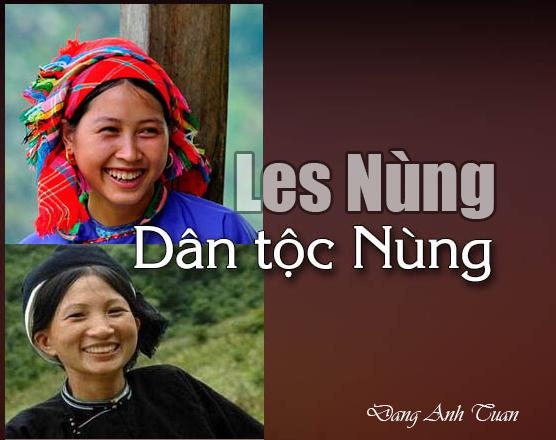 The Nùng
The Nùng